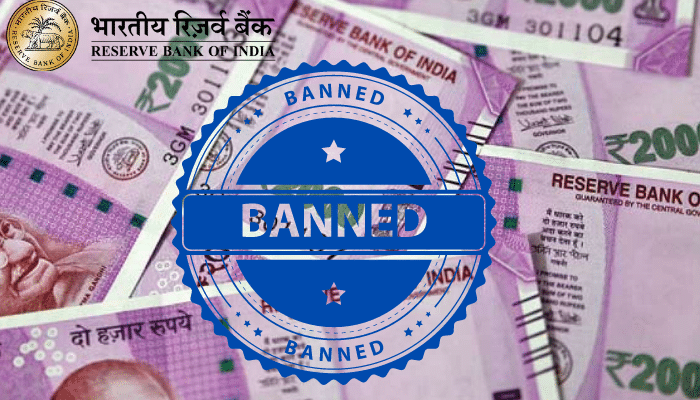LoanBaazar is excel in offering Home Loan, Mortgage Loan, Business Loan, Personal Loan, Education Loan, Credit Cards, SME Working Capital Loan and Equipment Finance at the most competitive rates from all leading Banks and NBFCs.

In a move that took the nation by surprise, the Reserve Bank of India (RBI) recently announced the recall of the ₹2000 note, triggering widespread speculation and debate. The ₹2000 note, introduced in 2016 as part of the government’s demonetization drive, was intended to curb black money and promote a digital economy. However, the sudden recall of this high-denomination currency has raised numerous questions about its impact on the economy, the rationale behind the decision, and the effectiveness of demonetization as a whole. In this article, we will delve into the recall of the ₹2000 note, examining the reasons behind it, its implications, and the potential alternatives that could have been considered.
The Origins of the ₹2000 Note
The ₹2000 note was introduced on November 8, 2016, as part of a larger demonetization exercise initiated by the Indian government. The primary objective was to combat corruption, curb black money, and promote the use of digital transactions. The decision to introduce such a high-denomination note was met with both praise and criticism. While some believed it would aid in reducing the circulation of black money, others expressed concerns about its potential for hoarding and illicit activities.
The Rationalization for Recall
The recall of the ₹2000 note, just a few years after its introduction, has left many puzzled. The RBI cited multiple reasons for the recall, including the need to address counterfeiting concerns and to realign the currency mix in circulation. Counterfeit currency is a pressing issue in India, and the ₹2000 note was found to be particularly vulnerable to duplication due to its high value and lack of effective security features. By recalling these notes, the RBI aims to replace them with a more secure currency that is harder to counterfeit.
Additionally, the recall is intended to rebalance the currency mix in circulation and restore the prominence of lower-denomination notes. The demonetization exercise in 2016 led to a significant reduction in the circulation of lower-value currency, causing inconvenience to the public, especially in rural areas where digital payment infrastructure is less prevalent. The recall of the ₹2000 note is an attempt to rectify this issue by increasing the availability of smaller denomination notes.
Impact on the Economy and Public
The recall of the ₹2000 note is expected to have both short-term and long-term impacts on the Indian economy. In the short term, there may be disruptions in cash transactions, particularly in sectors that heavily rely on high-denomination notes, such as real estate and luxury goods. However, the RBI aims to minimize the impact by ensuring a smooth transition and providing ample time for the public to exchange their old ₹2000 notes for the new currency.
Moreover, the recall may have implications for the informal economy, where cash transactions are prevalent. The sudden withdrawal of a high-value note could disrupt the cash flow and create temporary liquidity issues. However, proponents argue that the move will encourage the formalization of the economy and drive the adoption of digital payment systems.
In the long term, the recall is expected to have positive effects. The introduction of a more secure currency will help reduce counterfeiting, safeguarding the integrity of the monetary system. Moreover, the increased availability of smaller denomination notes will address the issues faced by the rural population and facilitate day-to-day transactions.
Alternatives and Criticisms
The recall of the ₹2000 note has not been without its share of criticisms and alternative suggestions. Some argue that instead of recalling the note, the government could have focused on improving security features to deter counterfeiting. Others believe that a gradual phase-out of the note would have been more prudent, allowing for a smoother transition.
Furthermore, critics argue that the recall of the ₹2000 note does not address the underlying issues of corruption and black money. They claim that individuals involved in illicit activities are likely to find alternative means to hoard or launder money. Instead, they propose a comprehensive approach that tackles the root causes of corruption and promotes transparency in financial transactions.
Additionally, concerns have been raised about the impact on the informal sector and the cash-dependent rural population. Critics argue that the recall could disproportionately affect these segments, leading to economic hardships for vulnerable communities. They suggest implementing measures to support and educate the affected population during the transition.
Conclusion
The recall of the ₹2000 note has sparked intense debates and discussions regarding its rationale, impact, and potential alternatives. While the decision aims to address counterfeiting concerns and rebalance the currency mix, it is essential to monitor its effects on the economy and public. Efforts should be made to minimize disruptions, provide adequate support to affected communities, and promote financial inclusion.
As the nation navigates through this recall, policymakers, economists, and the general public will continue to analyse the long-term implications of this unprecedented move. The path ahead lies in striking a delicate balance between curbing illicit activities, fostering financial transparency, and ensuring the welfare of all segments of society. Only time will reveal the true outcomes of this recall and shed light on its effectiveness as a tool in India’s fight against corruption and black money.